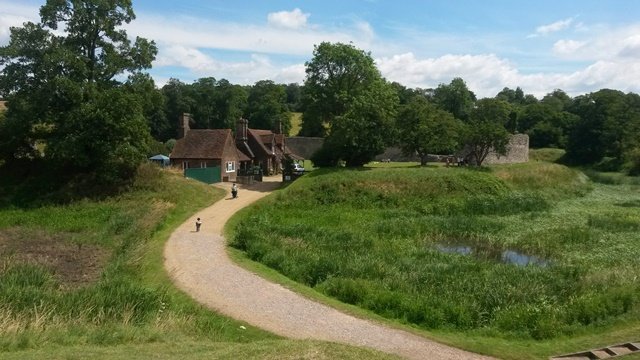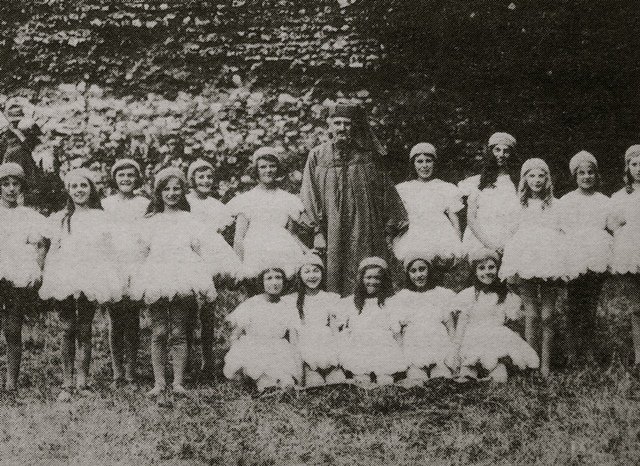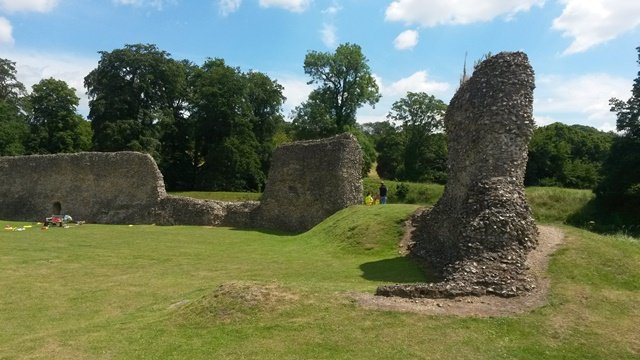‘Essentially an historical play’: Berkhamsted pageant play, 1922
*Guest Post by Laura Carter, a PhD candidate at the University of Cambridge*
In his 1976 autobiography, the writer Peter Quennell warmly recalled his childhood in Berkhamsted between the wars. At the town’s elite grammar school his classmate was the future novelist Graham Greene. Berkhamsted was in fact home to a community of writers in the 1920s, some of whom were the historical luminaries of their day. Quennell’s own parents, Charles and Marjorie, had achieved fame as authors of a series of illustrated children’s histories called A History of Everyday Things in England (1918-1934). The books were ‘an account of the work of the people, rather than the politics which guided them’. Close by were Janet and George Trevelyan, who moved to Berkhamsted with their two children after the First World War, and remained there until 1927. The Trevelyans resided minutes from the ‘unspoilt country, the downs, heaths and woods of Ashridge’. Peter Quennell remembered ‘tramping’ through these local woods by Trevelyan’s side. These memoirs set the scene aptly for the Berkhamsted pageant play of 1922. The occasion fused the spectacle of Edwardian historical pageantry, with interwar rural-preservationist sentiments, and the spirit of historical rigour embodied by the town’s esteemed residents.
The pageant was performed four times from Wednesday 5 until Saturday 8 July 1922. The week was beset with poor weather, with rain interrupting every performance except one. A souvenir booklet produced after the event cheerfully remarked that the weather was probably at least historically accurate, although ‘the clothes of the choristers weepingly bemocked their merry words’ as they sung ‘Sumer is i-cumen in’. These downpours were particularly disruptive as the chosen setting was outdoors, amidst the atmospheric ruins of Berkhamsted castle. The castle was the focal point for much of the pageant’s story. Originally the site of an Anglo-Saxon earthwork fort, the castle dates back to the eleventh century when an important Norman wooden motte-and-bailey castle was built. The stone ruins that remained into the twentieth century were of walls added by Thomas Beckett in the twelfth century.

On the approach to Berkhamsted Castle (taken by author)
The 1922 pageant was a commemorative occasion, marking the 700th anniversary of the local parish church of St Peter, which stood less than a mile south of the castle grounds. Although exact figures are not recorded, around 200 performers were involved; men, women, schoolchildren, and live horses included. Organizers were hard-pressed to encourage enough male participation at first, which was only rectified last minute when latecomers stepped in. Indeed, the whole affair seems to have been somewhat on the hoof. The majority of the costumes were hired, rather than homemade. The pageant was threatened with a year’s postponement when planning was partly underway due to a perceived lack of time to prepare. However, a public meeting called by the Rector of St Peter’s Church apparently galvanised the townsfolk and committee, rescuing the pageant play ‘from its doubtful plight, and [it was] in due course brought to a most happy fruition’.
Judging from the list of committee members, the pageant was an occasion for reinforcing or at least re-stating local hierarchies, at the top of which sat establishment elites and middle-class professionals. The Rector himself undertook the role of ‘Promoter of the Pageant’. The Chairman of the general pageant committee was Sir Lucius Granville Ram, a Q.C. whose family occupied Berkhamsted Place (a sixteenth-century manor) and who became First Parliamentary Counsel to the Treasury in 1937. Similarly, patrons of the pageant included local landowners and political elites. Sir Frederick Halsey (by 1922 an octogenarian) was from an old local family and, like his father, had been an MP for Hertfordshire, tracing his ancestral roots back to Plantagenet royalty. Another notable sponsor was Lord Brownlow, a prominent local landowner who had also been a Conservative MP. Until his death in 1921, Brownlow had resided at the Ashridge estate, which constituted the ‘unspoilt’ countryside on the north side of Berkhamsted. All of the advertisements in the souvenir booklet were for family firms located on Berkhamsted’s main high street. In the absence of more detailed archival material, it can be surmised that the pageant was envisaged as a reassuring civic occasion amidst the atmosphere of social instability in the immediate postwar years. Local elites and business-owners would have welcomed this sentiment at a time when the country at large faced extreme financial uncertainty, rising trade-union membership, and political realignment. Moreover, as in other suburbanizing areas within commuting distance of London, there was also a ‘new’ middle class in Berkhamsted in the 1920s advocating democratization. Both the desire to maintain clear hierarchies and the encouragement of popular participation therefore marked the pageant occasion.
In contrast to the majority of the committee members, the pageant master was not a local figure. Gilbert Hudson had cut his teeth on the Edwardian pageant circuit in Yorkshire, stepping in at the last minute to help organize the Thirsk historical play of 1907 and later acting as pageant master for Pickering pageant in 1910 and Scarborough pageant in 1912. Hudson defined his Berkhamsted endeavour as ‘essentially an historical play’. This comment reflects the emphasis on accuracy seen in the ‘Book of Words’. Hudson wrote the prologue and four episodes, and Trevelyan wrote the epilogue and five episodes (although episode nine was co-written with Gladys Morgan). Trevelyan’s historical credentials were by 1922 already confirmed. Although not yet established as a university academic, he had already published seven serious historical works grounded in detailed archival research. He had also begun to make a name for himself as a ‘popular’ historian. His wartime blockbuster English Social History (1944) would make him easily the best-known historian of the twentieth century.

Trevelyan (centre) as Chaucer (out of copyright)
Trevelyan had an innate ability to pitch historical research at the level of the ordinary reader, during a time when popular published history was in decline, and increasing disciplinary professionalization demanded history writing to be couched in precise detail and objective analysis. Between the wars, Sir Walter Scott’s tedious ‘Dr Dryasdust’ was frequently resurrected to poke fun at such writing. Trevelyan’s unusual capability therefore made him a perfect fit to contribute to the Berkhamsted script, and his keen popularizing instincts made it an attractive and novel proposition for him. Each scene in the ‘Book of Words’ was prefaced with a precise historical note drawing spectators’ attention to any ‘fictitious additions’ of the episode, versus that which had been based on documentary evidence. Key dates were presented in bold for the reader, mirroring the educative conventions of a history textbook.
The first episode, covering the Stone and Bronze Ages, was a nod to contemporary archaeological finds in the area. It was the first indication that the pageant was concerned to root Berkhamsted’s history in the very fabric of England: its landscape. Trevelyan became part of a high-profile National Trust campaign to save Berkhamsted’s surrounding countryside for the nation in 1925-6. The notion that Berkhamsted’s ‘Englishness’ was to be found deep in the woods of Ashridge ran throughout the pageant. In the ‘Book of Words’ an explanatory note written by Charles Quennell accompanied the prehistoric scene. The young Peter Quennell had proudly unearthed a yellow wolf’s tooth when exploring Ivinghoe Beacon (adjoining Ashridge), and he appropriately starred as one of the Bronze Age hunters in the pageant. Trevelyan’s Saxon scene (episode three) showed the Mercian King Offa holding court at Berkhamsted. Tensions between Christianity and the heathens are played out as King Offa attempts to avoid war with the kingdom of Wessex. The fourth episode portrayed one of Berkhamsted’s grandest moments. It saw William the Conqueror receive a deputation from London at Berkhamsted, and accept the English crown. The scene closes peacefully with William ordering the castle to be built up and protected. Notably, William vows to rule England as one nation, playing down the ‘Norman Yoke’ tradition.

The remains of the castle today (taken by author)
The emblem of the Berkhamsted pageant was the Black Prince, he is rendered standing triumphantly in front of the castle on the pageant poster, ‘Book of Words’, and souvenir booklet. The Prince occupied the castle regularly in the mid-fourteenth century at the height of its glory, depicted in episode six (the only one not written by Trevelyan or Hudson). Trevelyan’s starring moment came in the seventh episode, which he wrote and took centre stage for. In the character of Geoffrey Chaucer, one time Clerk of the Works to Berkhamsted castle, Trevelyan described the fate of the castle during the fifteenth century as it fell into decline. The impressive monologue reflected Trevelyan’s ‘celebrity’ status, both as a respected historian and a community elite. The Manchester Guardian praised Trevelyan’s performance ‘in a most-becoming smoke-grey cap and suit’. His final verse emphasised the relentless march of historical change, but not necessarily the advance of progress:
‘New times, new manners! Old must ever yield
Place to the new; it is too strait a field.
Yea, more than stone and mortar yield to age,
With the next Harry there shall come new rage’.
As the medieval prestige of the castle faded, scenes shifted focus onto the tumultuous early-modern period, with Elizabeth I’s unhappy spell at the nearby Ashridge Manor during the reign of Mary I. The young Elizabeth is presented sympathetically as she wonders through the dilapidated castle and bemoans the fate of her beloved rural England under her half-sister’s rule. She laments, ‘And as this Castle is, so now is England’. The pageant closed with a hymn written by the eighteenth-century poet William Cowper, who was born at St Peter’s church (his father was the Rector). The hymn underscored the religiosity at the heart of the pageant and its connections to the church establishment. The pageant featured six full songs in total as well as a performance of Beethoven’s fifth symphony as the closing tune. A special ‘Song of Berkhamsted’ was composed for the pageant. The lyrics (written by Hudson) expressed the celebration of a civic community as forged by tradition and embodied in the built heritage of castle and church:
‘So both to church and castle
Birth and growth we trace
Of Berkhamsted whose name is read
A fortified home place’
The Berkhamsted pageant play of 1922 is an interesting site for reflecting on the relationship between professional and amateur history, between print and pageant, in the interwar period. After the First World War there were profound optimisms about the role that a sound historical education might play in shaping future citizens. But such a feat demanded a dialogue between the historical profession and the ‘man on the street’. It required historians to think more tangibly and practically. The Quennells certainly pioneered a more demotic way of presenting the past, one that relied on ‘things’ and ‘work’ instead of politics. Not dissimilarly, Trevelyan could imagine and render English history as a series of colorful tableaux set against the scenery of England. This was the essence of the pageant, a nostalgic community affair with one eye firmly on the ‘democratic’ present. In his English Social History Trevelyan had tried ‘to tell the story rather like the scenes in a play’. Twenty years earlier, the pageant had given Trevelyan the opportunity to bring those scenes to life, performed and consumed by a microcosm of his reading populace. As he wrote to a close friend of the pageant experience, ‘for the first and last time in my life I had the pleasure of seeing my words and ideas acted, and quite well too’.
The 1922 pageant was ultimately deemed a modest success. It hailed the beginning of twentieth-century pageantry in Berkhamsted. Another pageant was performed at Berkhamsted castle just nine years later in order to raise funds for new parish buildings. The year 1931 also tied in with William Cowper’s bicentenary, whose place in the pageant was upgraded accordingly. The script used was very similar, with two extra episodes added in depicting Boadicea and the first Head Master of the school. Trevelyan was again involved in writing, although by this point he had moved away from Berkhamsted. Likewise, Hudson reprised his role as pageant master. In 1966 a much larger affair saw Berkhamsted mark 900 years since the Norman Conquest, celebrating the town’s critical role in William’s accession to the English throne.
Laura Carter
*For a photo of the cast in pageant dress, see http://www.berkhamsted-castle.org.uk/Pageants.html*
